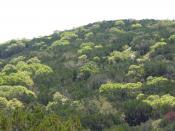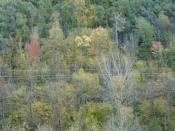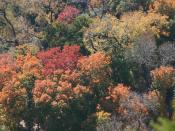The deciduous forest can be found all over the globe. It is found primarily in eastern North America, middle Europe, southwest Russia, Japan, and China but smaller scale deciduous forests can also be found in southeastern Australia, southern South America, and New Zealand. We will be discussing North American deciduous forests found in the Appalachian Mountains.
The deciduous forest plays an important and diverse role in the United States. The deciduous forest is found in the eastern part of the United States, and is estimated to cover approximately 302 million hectares, which is approximately 33% of the land area of the United States. We harvest many of our renewable resources from these forests such as lumber, minerals, and water. The forest also provides us with a variety of recreational activities including fishing, hunting, and hiking.
North American deciduous forests are much less diverse in the number of tree and animal species in comparison to the biodiversity which is found within a tropical rain forest.
Diversity may only range between 8-15 different tree species per hectare. Unlike tropical forests, where individuals of a particular species are thinly scattered, there are usually many individuals of the primary tree species in a given area in eastern deciduous forests. This biome can receive between 50-150 cm of annual precipitation. Precipitation primarily comes in the form of snow throughout the winter months. Deciduous forests experience four distinct weather seasons including spring, summer, autumn, and winter. The average temperature in temperate deciduous forests is roughly 75úF (24úC) but gets as high as 86úF (30úC), depending on the altitude of the forest. Forests higher in the mountains are colder. With the exception of evergreens, in the autumn months, the deciduous forest is famous for putting on a dazzling display of color changing leaves.


